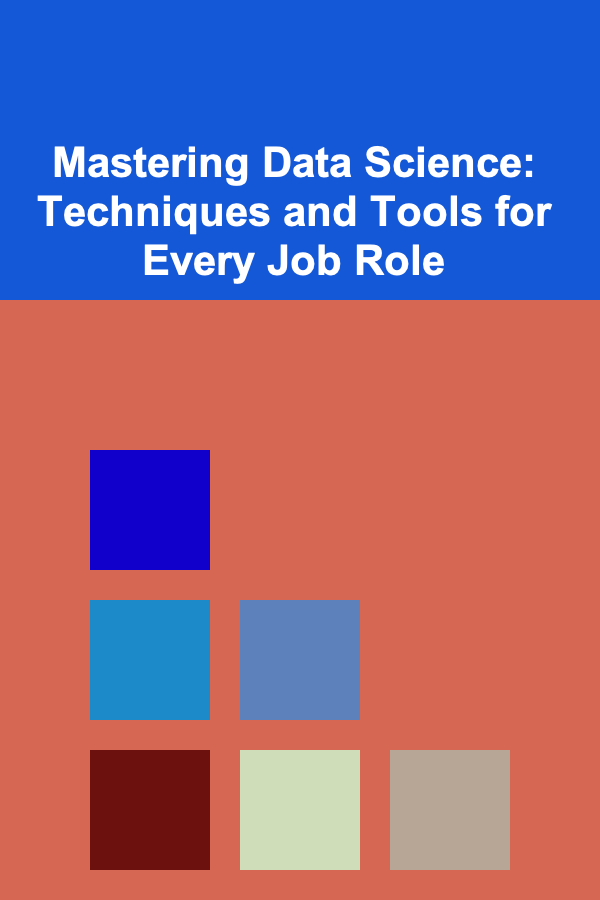
Mastering Data Science: Techniques and Tools for Every Job Role
ebook include PDF & Audio bundle (Micro Guide)
$12.99$9.99
Limited Time Offer! Order within the next:

Data science has emerged as one of the most crucial fields of the 21st century, influencing nearly every industry and job role. Whether you are working in healthcare, finance, marketing, or even education, the ability to harness and analyze data is becoming an essential skill. The field of data science is vast and continually evolving, offering numerous opportunities for professionals to master the tools and techniques that power data-driven decision-making.
This guide will delve into the techniques and tools that are essential for mastering data science in any job role. From data cleaning and visualization to machine learning and big data processing, we will explore the skills you need to succeed in this dynamic field.
Understanding the Foundations of Data Science
Before diving into advanced techniques and tools, it is crucial to build a strong foundation in data science. This foundation will help you understand the core concepts that underpin every application of data science.
1.1 Key Concepts
- Data Types and Structures: Understanding the types of data (numeric, categorical, etc.) and how they are structured (tables, arrays, matrices) is fundamental. Data scientists often work with structured and unstructured data, and knowing how to store, manipulate, and analyze it is crucial.
- Data Cleaning: Raw data is often messy. In fact, around 80% of a data scientist's time is spent cleaning data. This involves handling missing values, outliers, duplicates, and errors to ensure that the data is accurate and usable.
- Exploratory Data Analysis (EDA): Before applying complex algorithms, it's important to explore the data using statistical techniques and visualizations. EDA helps uncover trends, patterns, and anomalies in the data.
1.2 Core Skills
- Statistical Analysis: Understanding statistics is essential for analyzing data. Concepts like probability distributions, hypothesis testing, and regression analysis form the backbone of many data science techniques.
- Programming: The ability to write efficient code is essential for data science. Python and R are the two most popular languages in the field, with Python being especially favored due to its versatility and vast library support.
- Mathematics: A solid understanding of linear algebra, calculus, and optimization techniques is crucial for building and understanding machine learning models.
Tools and Technologies for Data Science
Data science tools are continually evolving, with new technologies emerging to meet the demands of larger datasets, faster computation, and more complex algorithms. Here's a breakdown of the most commonly used tools in various aspects of data science.
2.1 Data Cleaning and Preparation
- Pandas: Pandas is a Python library that provides easy-to-use data structures and data analysis tools. It is widely used for data wrangling, such as handling missing values, merging datasets, and transforming data.
- OpenRefine: This open-source tool is great for working with messy datasets. OpenRefine allows you to clean, transform, and visualize data, making it especially useful for large datasets that require extensive cleaning.
- Dplyr and Tidyr (R): These R libraries are excellent for data manipulation and tidying. Dplyr provides a set of functions to filter, arrange, and summarize data, while Tidyr focuses on reshaping data.
2.2 Data Visualization
Visualization is crucial for communicating insights from data, making it more understandable and accessible to stakeholders. A few popular tools include:
- Matplotlib and Seaborn (Python): These two libraries are essential for creating static, interactive, and animated visualizations. While Matplotlib provides fine-grained control over plot design, Seaborn simplifies the process for statistical data visualizations.
- Tableau: A powerful business intelligence tool for creating interactive and shareable dashboards. Tableau is used to analyze data visually and present insights in a compelling way for non-technical stakeholders.
- Power BI: Similar to Tableau, Power BI is a Microsoft tool that allows users to create interactive reports and dashboards. It's especially useful in organizations that rely on Microsoft products.
2.3 Machine Learning and Statistical Analysis
- Scikit-learn (Python): This Python library is one of the most widely used tools for building machine learning models. It offers a range of algorithms for classification, regression, clustering, and dimensionality reduction.
- TensorFlow and Keras: TensorFlow, developed by Google, is an open-source machine learning framework that enables scalable model training. Keras, a high-level API for neural networks, is built on top of TensorFlow and simplifies model building and experimentation.
- XGBoost: Known for its speed and performance, XGBoost is a popular gradient boosting framework for large datasets. It is widely used in machine learning competitions due to its high accuracy.
- R's Caret and MLR: These R libraries are powerful for machine learning workflows, offering a unified interface for model training, tuning, and validation.
2.4 Big Data and Distributed Computing
As data continues to grow in volume and complexity, big data technologies become increasingly essential. Here are some of the primary tools for handling large datasets:
- Apache Hadoop: Hadoop is an open-source framework that allows for distributed storage and processing of large datasets. It is used for batch processing, making it a great choice for analyzing big data in a fault-tolerant manner.
- Apache Spark: Spark is another open-source, distributed computing framework that performs much faster than Hadoop for certain tasks, especially in real-time processing. It supports various machine learning algorithms, SQL queries, and graph processing.
- Dask: Dask is a flexible parallel computing library for Python that integrates with existing libraries like NumPy and Pandas to scale up computations on large datasets.
- Databricks: Databricks is a unified analytics platform built around Apache Spark, allowing data engineers, data scientists, and business analysts to collaborate in a shared environment.
2.5 Cloud Computing Platforms
Cloud platforms allow for scalable data storage, processing, and machine learning. Some of the leading platforms include:
- Amazon Web Services (AWS): AWS provides a comprehensive suite of tools for storage (S3), processing (EC2), and machine learning (SageMaker). It's particularly useful for scaling data science workflows and deploying machine learning models to production.
- Google Cloud Platform (GCP): GCP offers a variety of tools for data science, including BigQuery for data analysis and TensorFlow for machine learning. It's known for its scalability and integration with Google's other services.
- Microsoft Azure: Azure provides a wide range of cloud-based services for data storage, analytics, and machine learning. Azure Machine Learning is a particularly popular tool for model building and deployment.
Key Techniques in Data Science
Mastering the techniques of data science involves not only using the right tools but also understanding when and how to apply specific techniques to solve real-world problems.
3.1 Machine Learning
Machine learning forms the backbone of many data science applications. Understanding the various types of machine learning algorithms is crucial.
- Supervised Learning: In supervised learning, models are trained on labeled data to predict outcomes for new, unseen data. Common algorithms include linear regression, decision trees, and support vector machines (SVM).
- Unsupervised Learning: Unsupervised learning involves identifying hidden patterns in data without pre-labeled outcomes. Common algorithms include clustering (e.g., K-means) and dimensionality reduction (e.g., PCA).
- Reinforcement Learning: This technique is used to build models that learn through interaction with an environment. It is widely used in applications such as robotics, gaming, and autonomous vehicles.
- Deep Learning: Deep learning is a subset of machine learning that involves neural networks with multiple layers. It's particularly useful for tasks involving large amounts of unstructured data like images, text, and audio.
3.2 Statistical Modeling
Statistical modeling techniques help data scientists understand relationships between variables and make predictions. Some key techniques include:
- Regression Analysis: This technique is used to model the relationship between a dependent variable and one or more independent variables. Linear regression is the simplest form, but techniques like logistic regression are used for classification tasks.
- Time Series Analysis: Time series data (data indexed by time) often requires specialized techniques like ARIMA (AutoRegressive Integrated Moving Average) and exponential smoothing for forecasting.
- Bayesian Statistics: This statistical approach incorporates prior knowledge (prior distributions) along with new data to update beliefs about the system being modeled. It's widely used in areas like decision-making and predictive modeling.
3.3 Natural Language Processing (NLP)
Natural Language Processing (NLP) enables computers to understand and generate human language. Some key techniques include:
- Text Classification: Text classification assigns predefined categories to text based on its content. Applications include sentiment analysis, spam detection, and topic categorization.
- Named Entity Recognition (NER): NER identifies and classifies entities (like names of people, organizations, dates, etc.) within a body of text, which is useful for information extraction.
- Topic Modeling: Topic modeling techniques, like Latent Dirichlet Allocation (LDA), are used to uncover hidden topics in a collection of documents.
Conclusion: A Path to Mastery in Data Science
Mastering data science requires continuous learning, as the field is constantly evolving. By mastering the techniques and tools outlined in this guide, you can gain the expertise to tackle complex data challenges in any job role. Whether you're analyzing customer behavior, predicting stock prices, or diagnosing diseases, data science empowers you to make informed, data-driven decisions.
The journey to becoming a proficient data scientist may seem overwhelming at first, but with dedication and the right approach, you will be well-equipped to navigate the ever-expanding world of data science. By staying up-to-date with new tools, technologies, and methodologies, you will position yourself for success in the data-driven world.
Reading More From Our Other Websites
- [Home Lighting 101] How to Mix Different Types of Lighting for a Balanced Look
- [Survival Kit 101] The Best Minimalist Survival Kit for College Students Living in Small Dorm Rooms
- [Personal Care Tips 101] How to Burn Fat with High-Intensity Interval Training (HIIT) and Proper Nutrition
- [Star Gazing Tip 101] Building a DIY Telescope: Hands-On Techniques for Student Astronomical Research
- [Organization Tip 101] How to Use Affirmations to Stay Motivated in Time Management
- [Home Soundproofing 101] How to Soundproof a Home for a Better Work-from-Home Setup
- [Personal Investment 101] From Knowledge to Income: How to Monetize Deep Learning Expertise
- [Home Staging 101] How to Incorporate Low-Maintenance Plants When Staging a Yard for Busy Homebuyers
- [Home Pet Care 101] How to Build a DIY Pet Ramp: Enhancing Accessibility and Comfort for Aging or Injured Pets
- [Home Cleaning 101] How to Clean and Care for Your Microwave

How to Avoid Lifestyle Inflation and Stay on Track with Your Finances
Read More
How to Prepare Your Finances for Buying a Car
Read More
How to Set Realistic Meal Prep Goals for Yourself
Read More
How to Set Up a Checklist for Holiday Window Decorations
Read More
Smart Ways for Saving on Childcare Expenses Without Compromising Quality
Read More
10 Tips for Integrating Nutrition into Your Fitness Planner
Read MoreOther Products

How to Avoid Lifestyle Inflation and Stay on Track with Your Finances
Read More
How to Prepare Your Finances for Buying a Car
Read More
How to Set Realistic Meal Prep Goals for Yourself
Read More
How to Set Up a Checklist for Holiday Window Decorations
Read More
Smart Ways for Saving on Childcare Expenses Without Compromising Quality
Read More